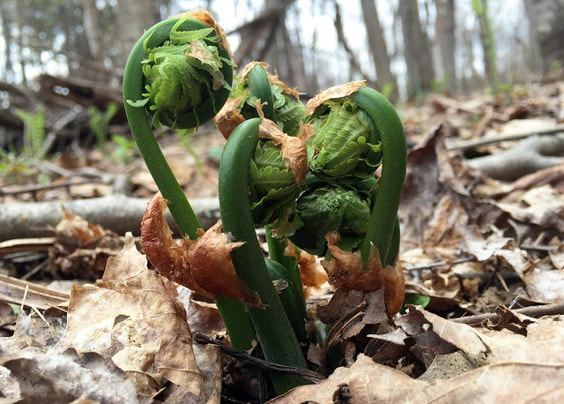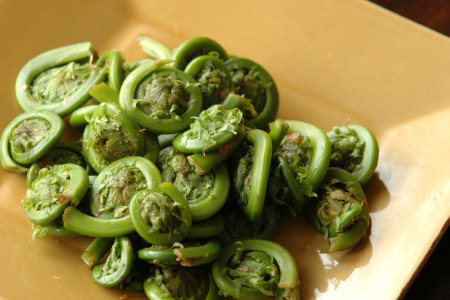Annual Repost
Foraging for fiddleheads is a favorite spring activity of mine. Each spring, not long after the snow melts, and before the bugs are a problem, the ferns push their way up through the forest floor, uncurling slowly. It's at this moment just before they uncurl that it’s time to harvest them. They are usually available for about three weeks where I live in Southern New England. They usually start the second or third week of April. Last year I started picking on April 12th. That was one week after the cherry blossoms bloomed in Washington DC.
Fiddleheads are the young coiled fronds of the ostrich fern. Nearly all ferns have fiddleheads, but the ostrich fern is very distinct. Ostrich fern fiddleheads, are about an inch in diameter, can be identified by the brown papery scale-like covering on the uncoiled fern, and the deep ”U”-shaped groove on the inside of the fern stem.
Depending on where you live, the start emerging in mid April, May, and early June on the banks of rivers, streams, and brooks throughout the northeastern United States.
To prep the fiddleheads, any leftover “silk” should be removed. The silk is a thin, brown, papery covering that resembles a peanut casing. You can rub it off with your fingers in a bath of cold ice water. Drain the water and then rinse them again in a bowl of cold water, gently agitating them with your fingers and pouring off the water until it is free of particles. Drain well and pat dry.
These springtime delicacies have a taste reminiscent of asparagus. If you cook the fiddlehead like an asparagus you really can’t go wrong. Their flavor is mild, they are pleasantly crunchy. They can be cooked in many different ways, from steamed, to boiled, or dipped in beer batter and fried. I like them sautéed with some garlic and lemon juice in olive oil and butter, lightly sprinkled with salt and pepper. There are many recipes to be found on the internet so you can pick them, wash and they will freeze well. It is recommended that you cook them for at least 10 and up to 15 minutes before you eat them. Fiddlehead ferns contain a toxin that causes stomach pain in humans when ingested. The toxin is destroyed by the heat generated during the cooking process.
If you have never tried canning them before and want to give it a try, head out to the store and buy a case of canning jars for less than ten dollars. You will also need a good set of tongs to remove the jars from the boiling water pot during the water bath canning method.
“Good Diggin"


 RSS Feed
RSS Feed